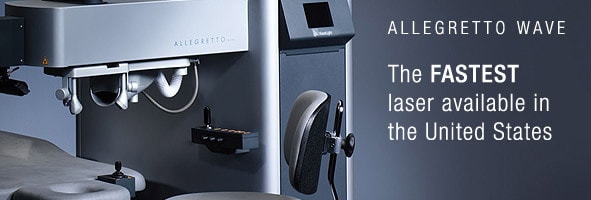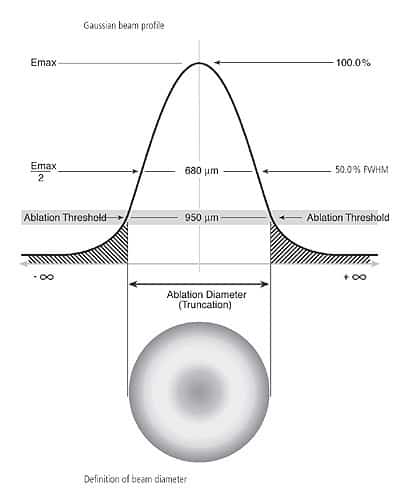
The Wavelight Allegretto laser is the most precise system with the fastest laser pulse rate of any FDA-approved laser system available in the United States. It is also among the safest and most stable of laser systems. Let’s break this down and discuss each component, one by one.
Precision
Lasers that correct vision accomplish their effect by sculpting a shape change in the cornea. In a nearsighted eye, correction with glasses or contacts requires addition of a concave lens in front of the eye. Laser treatment works instead by sculpting to subtract a convex lens-shape from the cornea. If each laser pulse takes a tiny, sub-microscopic “bite,” then in aggregate the entire treatment (all pulses) must sculpt exactly the intended shape change. The more precisely each “bite” can be known, the more precise the shape removal can be, and the better the precision of the final result. Optical physicists describe laser effects in terms of beam shape, beam diameter, and energy density or fluence. It is self-evident that consistency of beam characteristics is crucial to reproducibility of results. A Schematic of the Allegretto beam profile is shown below.

On several levels, the Wavelight Allegretto laser performs better than other laser systems for vision correction. The main laser ‘engine’ is extremely stable over very long time intervals (hours and days) relative to the intervals employed in treatment (seconds). The laser beam is among the smallest and most consistent produced by any laser system, so the “bites” of each pulse are uniform. The laser beam shaping system has the fewest moving parts of any system for vision correction applications, affording consistency and reliability. The beam shaping section of the laser is specially designed to maximize performance of each optical component, including lenses and mirrors, used to shape and aim the beam (using a sealed beam chamber and Nitrogen gas ‘washout’ after treatment).
Speed
Rest assured, nobody is trying to break any ‘speed records’ in the rendering of laser treatment to correct vision. However, it is important to render treatment as efficiently and expeditiously as possible. The cornea is living tissue, and the collagen layer (the part sculpted in LASIK) contains some water. In LASIK, a superficial flap is created, then opened, and remains open for the duration of laser treatment. During even the short intervals involved in modern laser treatment, the longer the flap is open, the more water can evaporate from the exposed tissue. This is referred to as stromal dehydration , and relatively dehydrated stroma will have a slightly greater collagen fiber density (less water between the fibers), so laser pulses will remove slightly more collagen tissue per pulse than in normally hydrated tissue. These effects are small, but not insignificant. The faster the laser treatment can be rendered, the less stromal dehydration can (adversely) affect the desired result. For higher corrections, the treatment time difference (between Allegretto and other lasers) may approach or exceed one minute, and this is significant when considering evaporative dehydration issues. All other factors being equal, “faster is better” in a laser treatment context, for this reason. The Wavelight Allegretto laser operates at a pulse rate of 400 pulses per second, which is more than twice as fast as other “scanning spot” systems.
Safety
One of the most common issues people ask about (in the context of laser vision correction) is, “How can I know that the treatment will be safe, and will go the way we want?” There are three components to address in this regard:
- Risks related to creation of the LASIK flap;
- Safety of the laser treatment; and
- Post-operative considerations (stability of correction, risk of problems, need for enhancement)
We will address here the issue of laser safety (the other issues are discussed elsewhere on the site). All lasers approved for use in vision correction by the FDA must demonstrate numerous safety features. These include, but are not limited to the following:
- Providing for electrical power backup in case of a power outage (they all have “UPS” backup systems)
- Providing a means to calibrate and measure energy at the point of treatment
- Design of built-in safeguards that will pause treatment if necessary should there be any malfunction detected within the laser, with the ability to resume treatment from where it was paused
- Systems must exist to pause treatment if the eye tracker should fail to maintain fixation on the eye being treated, with methods to confirm fixation and resume treatment thereafter
- Extensive documentation of operation, service and maintenance
“LA Sight surgeons and staff ensure that our systems provide for the highest level of patient safety. Every component of our process must demonstrate exceptional safety and accuracy, including the lasers that we use to render treatment. Quite simply, we wouldn’t have it any other way.” — Dr. Wallace.